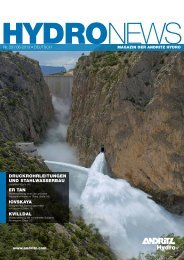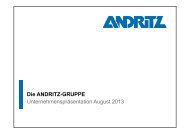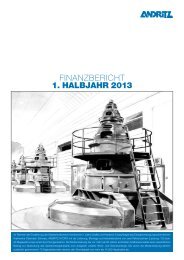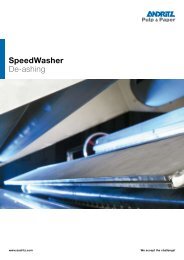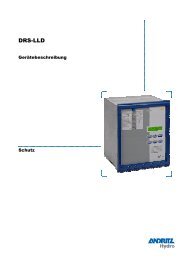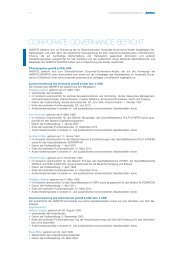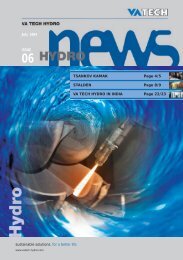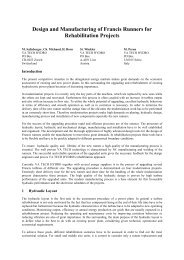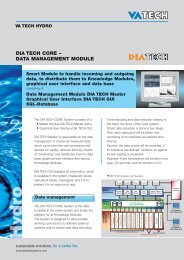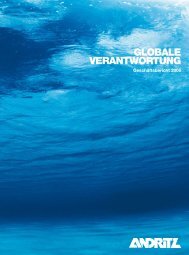In March 2012 ANDRITZ HYDRO - ANDRITZ Vertical volute pumps
In March 2012 ANDRITZ HYDRO - ANDRITZ Vertical volute pumps
In March 2012 ANDRITZ HYDRO - ANDRITZ Vertical volute pumps
You also want an ePaper? Increase the reach of your titles
YUMPU automatically turns print PDFs into web optimized ePapers that Google loves.
12 <strong>HYDRO</strong>NEWS Top news<br />
<strong>ANDRITZ</strong> <strong>HYDRO</strong><br />
Hammerfest<br />
New technology for <strong>ANDRITZ</strong> <strong>HYDRO</strong><br />
As renewable energy plays a<br />
growing role and international<br />
concerns about global<br />
warming increase, governments,<br />
policymakers, citizens and companies<br />
are reexamining the question of<br />
the right mix of energy resources<br />
and the factors that should contribute<br />
to determining this mix.<br />
<strong>In</strong> line with these important goals, in<br />
mid-2010 <strong>ANDRITZ</strong> <strong>HYDRO</strong> decided to<br />
expand its product portfolio by acquiring<br />
shares in the Norwegian company<br />
Hammerfest Strøm. This company is a<br />
world market leader in technologies for<br />
energy generation using tidal currents in<br />
coastal waters. At the same time it is<br />
actively holding its position in the promising<br />
new ocean power market.<br />
By end of 2011 participation in the<br />
company had increased from 33.3% to<br />
55.4%. Other major shareholders in the<br />
company are local Norwegian utility<br />
Hammerfest Energi and Spanish utility<br />
Iberdrola. The company, which now operates<br />
as <strong>ANDRITZ</strong> <strong>HYDRO</strong> Hammerfest,<br />
is based in the Norwegian city of<br />
Hammerfest and has a subsidiary in<br />
Glasgow, Scotland.<br />
First 1 MW tidal current turbine<br />
<strong>In</strong> December 2011, <strong>ANDRITZ</strong> <strong>HYDRO</strong><br />
Hammerfest successfully deployed its<br />
1 MW pre-commercial tidal turbine designed<br />
to validate the technology for<br />
the world’s first tidal power array. The<br />
machine was installed at the European<br />
Marine Energy Centre (EMEC) in Orkney,<br />
Scotland. The site provides the<br />
world’s only multi-berth, purpose-built,<br />
open sea test facilities for wave and<br />
tidal marine energy converters. For tidal<br />
energy converters, EMEC operates<br />
seven test sites at the Fall of Warness<br />
of the island of Eday. Meanwhile, the<br />
device has been successfully synchronized<br />
to the grid, delivering power on<br />
the first attempt during initial start-up.<br />
<strong>ANDRITZ</strong> <strong>HYDRO</strong> Hammerfest's<br />
HS1000 tidal device is a horizontal axis<br />
turbine, similar to a wind turbine,<br />
mounted and locked onto a solid steel<br />
structure and positioned on the seabed.<br />
The rotor blades are driven by<br />
water currents and coupled to an electric<br />
generator through a step-up gearbox.<br />
Additionally, a dedicated blade<br />
pitching system allows optimum adjustment<br />
of the rotor blade to the direction<br />
and speed of the tidal current.<br />
The new HS1000 turbine is based on<br />
the technology used in the HS300 prototype,<br />
a smaller turbine with 300 kW<br />
electrical outputs. The HS300 was installed<br />
in Norway as the first tidal current<br />
turbine, with a permanent connection<br />
to the public grid in 2004. The<br />
prototype was in operation for more<br />
than 17,000 hours, delivering power to<br />
the grid with 98% availability during<br />
testing.<br />
<strong>In</strong>stallation under turbulent conditions<br />
The EMEC site is considered to contain<br />
some of the most hostile waters worldwide.<br />
Nevertheless, installation of the<br />
HS1000 was carried out during the<br />
worst operational deployment period of<br />
the year, with extremely strong winds<br />
and high waves. A special heavy-lift<br />
vessel, dynamically positioned, was<br />
used to guarantee precise positioning of<br />
the device. Methodologies and procedures<br />
were defi ned so that the equipment<br />
could be installed without the<br />
support of divers, which would have<br />
been much too dangerous in such an<br />
environment. The marine installation<br />
was monitored by remotely operated<br />
vehicles (ROV) equipped with video<br />
cameras which transmitted the images<br />
on board the vessel to the operators.<br />
World’s first tidal turbine array<br />
The HS1000 device, which covers the<br />
annual electricity needs of 500 homes,<br />
is the same machine that will be used<br />
by Scottish Power Renewables (SPR)<br />
as part of the world’s fi rst tidal turbine<br />
array in the Sound of Islay. The company’s<br />
plans to develop a 10 MW tidal array<br />
received consent from the Scottish<br />
Government in <strong>March</strong> 2011. Beyond<br />
this, SPR aims to use the turbine as<br />
part of even larger-scale projects currently<br />
under investigation in the Ness<br />
of Duncansby, as part of The Crown<br />
Estate’s Pentland Firth leasing round.<br />
Realization of demonstration projects is<br />
seen as a vital step towards fully utilizing<br />
the great potential of power generation<br />
from tidal currents. <strong>In</strong> this scenario,<br />
the Islay project will play a key role in<br />
helping to verify a range of factors necessary<br />
for large-scale deployment of the<br />
technology.<br />
Peter Gnos<br />
Phone: +43 50805 5 2694<br />
peter.gnos@andritz.com



